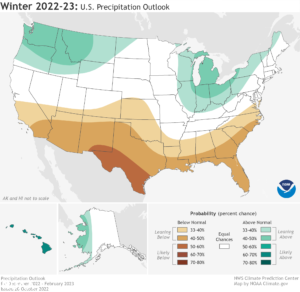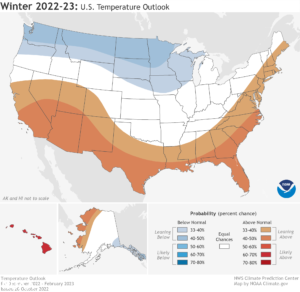2022-2023 Winter Outlook
October 20, 2022, – Forecasters at NOAA’s Climate Prediction Center released the 2022-23 U.S. Winter Outlook.
“This year La Niña returns for the third consecutive winter, driving warmer-than-average temperatures for the Southwest and along the Gulf Coast and eastern seaboard, according to NOAA’s U.S. Winter Outlook released today by the Climate Prediction Center — a division of the National Weather Service. Starting in December 2022 through February 2023, NOAA predicts drier-than-average conditions across the South with wetter-than-average conditions for areas of the Ohio Valley, Great Lakes, northern Rockies and Pacific Northwest.”
“While it’s a little intimidating to put on these oversized shoes, I’m forging ahead in an annual ENSO Blog tradition and giving you all the juicy details about NOAA’s Winter Outlook (1). Regular readers may remember that Mike Halpert of the NOAA Climate Prediction Center (CPC) has been the blog’s winter outlook guru for years, but following Mike’s retirement earlier this year, I’ll be leading you on this year’s journey (Mike, I will try to make you proud!). And maybe my job will be pretty easy this time, given that we are expecting a third consecutive winter with La Niña conditions in the tropical Pacific. What will that mean for this winter? Let’s find out!”
” Winter Outlook enthusiasts are likely aware of how much the occurrence of La Niña (as well as El Niño) can shape the outlook, and for good reason: ENSO, the El Niño/Southern Oscillation (the entire El Niño and La Niña system), exerts a significant influence on winter climate over North America. This influence translates into enhanced temperature and precipitation predictability, as previous events often share some common features. For example, as Mike described in each of the past two years, most of the 20 strongest La Niña events since 1950 brought drier-than-average conditions across much of the southern tier of the U. S., particularly along the Gulf Coast. On the flipside, the Great Lakes/Ohio Valley region, the Pacific Northwest, and the northern tier of the U.S. tended to be wetter than average, although there is less consistency to these La Niña impacts.” said Nat Johnson, NOAA Geophysical Fluid Dynamics Lab.
The 2022-23 U.S. Winter Outlook (December through February):
Precipitation
- The Pacific Northwest, northern Rockies, Great Lakes and parts of the Ohio Valley and western Alaska have the greatest chances for wetter-than-average conditions.
-
Drier-than-average conditions are favored in south-central Alaska, southern California, the Southwest, and the Southeast.
- The forecast for the remainder of the U.S. shows equal chances for below-, near- or above-average precipitation during winter months.
- The greatest chance for warmer-than-average conditions are in western Alaska, and the Central Great Basin and Southwest extending through the Southern Plains.
-
Warmer-than-average temperatures are also favored in the Southeastern U.S. and along the Atlantic coast.
- Below-normal temperatures are favored from the Pacific Northwest eastward to the western Great Lakes and the Alaska Panhandle.



